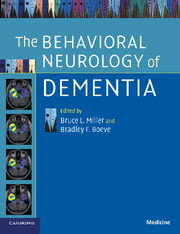Book contents
- Frontmatter
- Contents
- List of contributors
- Section 1 Introduction
- 1 Basic clinical approaches to diagnosis
- 2 Dementia with Lewy bodies
- 3 Neurogenetics of dementia
- 4 Frontotemporal dementia
- 5 Alzheimer's disease
- 6 Mental status examination
- 7 Neuropsychiatric features of dementia
- 8 Neuroimaging in dementia
- 9 Epidemiology and risk factors
- 10 Animal models of dementia
- 11 Neuropathology of dementia
- Section 2 Cognitive impairment, not demented
- Section 3 Slowly progressive dementias
- Section 4 Rapidly progressive dementias
- Index
1 - Basic clinical approaches to diagnosis
Published online by Cambridge University Press: 31 July 2009
- Frontmatter
- Contents
- List of contributors
- Section 1 Introduction
- 1 Basic clinical approaches to diagnosis
- 2 Dementia with Lewy bodies
- 3 Neurogenetics of dementia
- 4 Frontotemporal dementia
- 5 Alzheimer's disease
- 6 Mental status examination
- 7 Neuropsychiatric features of dementia
- 8 Neuroimaging in dementia
- 9 Epidemiology and risk factors
- 10 Animal models of dementia
- 11 Neuropathology of dementia
- Section 2 Cognitive impairment, not demented
- Section 3 Slowly progressive dementias
- Section 4 Rapidly progressive dementias
- Index
Summary
There are few areas in all of medicine that are more difficult, yet gratifying, than the assessment, diagnosis and treatment of patients with cognitive complaints. Since the mid 1990s there have been dramatic changes in the accuracy of dementia diagnosis with improvements seen not only for Alzheimer's disease (AD), but also many of the other non-AD conditions including frontotemporal dementia (FTD), dementia with Lewy bodies (DLB), vascular dementia and Jakob–Creutzfeldt disease (CJD). Simultaneously, better detection and differential diagnosis of mild cognitive impairment (MCI), a condition that often represents an early stage of a specific degenerative or cerebrovascular condition, is now possible. One of the major reasons for these improvements is that research is helping to reveal specific roadmaps for the detection of each of these conditions, while simultaneously devising systematic approaches to rule out potentially treatable non-degenerative etiologies for cognitive impairment.
In this chapter, a simple approach to dementia at the bedside is described and clinical diagnosis is outlined with regards to the following categories:
the history
the examination including cognitive, behavioral, medical and neurological findings
laboratory testing including genetic testing and brain imaging.
Additionally, a simple approach to treatment of the varied dementing conditions is described. With the approaches outlined in this chapter, a clinician can make highly accurate diagnoses for all of the major degenerative and vascular dementias and MCI, while simultaneously generating appropriate treatments once a diagnosis has been made.
- Type
- Chapter
- Information
- The Behavioral Neurology of Dementia , pp. 1 - 6Publisher: Cambridge University PressPrint publication year: 2009
- 1
- Cited by

